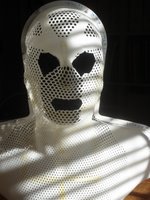Wait and see
 After only a couple of visits to the hospital we belong there, we're in the club, know where to go and what to do. Even I, the appendage, feel that I have my place under its Oncology Wing.
After only a couple of visits to the hospital we belong there, we're in the club, know where to go and what to do. Even I, the appendage, feel that I have my place under its Oncology Wing. We clock up a few hours in the radiotherapy waiting areas. Someone on the staff (clerical, I suspect, without knowing why) has a subscription to Gardens magazine (NOT Gardens Illustrated which would be a completely different kettle of fish; you probably have to be BUPA to find that in a waiting room), and there is Country Life, some old Cosmopolitans and a Vogue. Nothing housey. By the time Major's initial simulation is over I have flicked through the whole stack, spending most time with Hello, circa May 2003. That distraction out of the way, the real waiting game can begin which is Observation (subtitled Guess the Cancer).
The radiotherapy labs keep office hours, Monday to Friday, 9-5, so there's no shift work, and we see the same sets of staff most times, and, often, the same patients. This is surprising as the sessions are short, no more than 4 minutes or so, and the waiting areas are usually busy. Maybe it's to do with the settings of the machines, since the strength of x-rays changes throughout the treatment; some weeks a full-on zapping, other weeks a mere tickle, the machine teasing the tumor like a cat with a mouse. Maybe the patients we see are all in step with Major and his course, though their cancers are in different bits. The thought of the planning this would involve hurts my head; it's more likely to be the alphabetical order of their names... In any case, a lot of people in the South East of England are taking a nuking.
Many of the women go into cubicles when they arrive, and exchange their tops for blue hospital smocks, and their shoes for thick socks that look as if they belong to wet suits. I guess from the smocks that they have breast cancer, though the socks are a bit of a mystery.
During half-term, children accompany their mothers, swinging their dangling legs from chairs, and finding things to fidget over and giggle at, delightfully shadow-free.
There are men with red patches on their necks, areas of burning defined by straight lines, so maybe they're oropharynx like Major, though the thing about this game is that you never know - it could be the bones, or something else in the neck that is cancerous rather than the squamous cells. (In the beginning, Graham told us that there's a cancer for every bit of the body, and showed us a willy immobilisation unit he'd made.)
There are out-patients in wheelchairs brought in by porters from the NHS bus who will have to wait for all of their fellow passengers to be treated before they can go home again, and in-patients with no hair, wheeled up from the wards in their bed clothes. An old man is brought along in his bed, and we watch his progress through a whole week at the same time every day. He starts off on Monday sprouting tubes, frail and semi-conscious , and by Friday his hair is neatly brushed and he's alert. I would like to say hello (my Oncology Club membership might allow me to) but am not able to break through the bed/dignity/big-mouth, nosy soprano thing.
One day there is a prisoner waiting with two guards, one of them joined to him by handcuffs. He is round-shouldered and cowed, not a malignant presence, but weighty, more priest than paedophile. He looks like Shylock, or a faded flamenco king, or an aging Indian chief; swarthy, pock-marked skin, a huge hook nose and intense greeny blue eyes that make me think of exotic fish, though I only get the quickest glimpse as he casts them down to the floor. He is not your average man of Kent. A skull cap is on his head, but in place of robes, regulation jeans and a plum sweatshirt dress his thin body; they express nothing of him but the loss of his expression. In contrast, the beefy anglo-saxon guards are completely at ease with all that their black and white uniforms and shaved heads say of them. There is no interaction with their charge, but they chat and laugh with each other. Really, casting and wardrobe have excelled themselves again; I even forget to guess.
Major's favourite team is at LA3, particularly Rachel who has warmth and curiosity, and quickly tunes into his way of being. The boys in LA2 do not possess such charm; they call the patients' names with their heads in their clip-boards, then "date of birth?" across the room when the patients are barely out of their chairs. These are people they see day after day, for weeks sometimes, but Major says they're OK once he's inside the lab, and anyway, much better that they're really quick with the mask business.
Most times Graham will saunter through at his slow andante, "it's all go today...". He'll stop for a chat, and ask Major the time of his appointment, then look at his watch. The machines can be temperamental, and have cranky days when they don't work well, causing delays. On such days Graham has a word with the lads, and Major's name, as if by magic, will be the next one called. Major oils this system with gifts of strawberries and apples for the teams, whatever he finds at the farm stalls on his way in. He and Graham share an innate understanding of what makes people tick, and would thrive on any black market. They're natural survivors.



